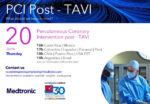While transcatheter aortic valve replacement (TAVR) has shown benefits, significant coronary artery disease affects 50% or more of patients who undergo such procedure. However, it is still unclear which is the best treatment strategy or how to handle this condition. Quantitative flow ratio (QFR) could be a non-invasive option to assess the severity of coronary...
Events in CAD Patients Who Refused or Were Ineligible for CABG
When deciding on the optimal coronary artery revascularization treatment of coronary artery disease (CAD) patients, physicians normally assessed clinical presentation, surgical risk, survival expectation, and the likelihood of a better quality of life. Decisions are made after careful consideration, by the Heart Team, who will ponder options such as coronary artery bypass graft (CABG), percutaneous...
TAVI in Horizontal Aorta: Neo2 vs. Sapien Ultra
There are controversies regarding transcatheter aortic valve implantation (TAVI) in cases of challenging anatomical complexity, such as horizontal aorta (HA). This is primarily because aortic angulation (AA) impacts the procedure differently depending on the valve type used. As previously studied, angulation complicates crossing, implantation, and coaxial positioning with commissural alignment. In the study presented by...
Antiplatelet Treatment with Ticagrelor vs. Clopidogrel in Patients with Chronic Coronary Syndrome
Achieving rapid and maximum inhibition of platelet aggregation can reduce complications related to scheduled percutaneous coronary intervention (PCI) in chronic coronary syndromes (CCS). Over the last few decades, the optimal timing for initiating P2Y12 inhibitors and their appropriate dosage have been the subject of numerous studies; however, they have not been clearly established yet. Higher...
Glycemic Control and Coronary Stent Failure
Diabetic patients have twice as high a risk of developing coronary artery disease (CAD). Additionally, CAD increases mortality risk. Patients with a history of percutaneous coronary intervention (PCI) tend to need repeat revascularization, even with second generation stents. To date, there are few studies assessing the role of glycemic control in stent failure, stent thrombosis,...
Coronary Angioplasty with Sirolimus Eluting Stents
At present, most percutaneous coronary intervention procedures (PCI) are done with drug eluting stents (DES). However, drug coated balloons (DCB) have shown benefits in restenosis and small vessel de novo lesions. Intravascular ultrasound (IVUS) has been shown effective in left main PCI and complex procedures, even though there is little infomration on its use for...
06/20 | SOLACI Webinar: Post-TAVI percutaneous coronary intervention. Register now
A new virtual educational event organized by the Latin American Society of Interventional Cardiology with the support of Medtronic is approaching. On this occasion, we will hold a 90-minute event on Post PCI – TAVI with renowned Latin American specialists and the presence of Dr. Gilbert Tang (USA). Consult the scientific agenda and register. The...
Pre-Catheterization Fast
It has been generally established that coronary procedures with local anesthesia and moderate sedation minimally require a 6 hour fast for solids and 2 hours for liquids (according to SCAI guidelines 2021). However, complications requiring emergency orotracheal intubation are extremely rare. Prolonged fasting can have adverse effects such as hypoglycemia, insulin resistance, acute renal failure...
Microvascular Resistant Reserve: Impact on STEMI Patients
Coronary Microvascular Dysfunction (CMD) is being increasingly considered a common consequence of STEMI. Its presence partly explains the persistence of angina symptoms in over 50% of patients after PCI, despite successful epicardial artery reperfusion. Also, CMD has been independently associated with worse left ventricular ejection fraction recovery, which leads to worse prognosis, including recurrent events,...
REPLICA-EPICA 18 Registry: Using IVL in Calcified Coronary Lesions
The presence of calcification in the coronary arteries (CAC) remains the main challenge in the percutaneous treatment of these lesions. Various studies have demonstrated the association of CAC with unfavorable long-term outcomes. Intravascular lithotripsy (IVL) has emerged as an effective tool for fracturing calcified plaques. Studies evaluating this strategy have shown high device success rates,...









